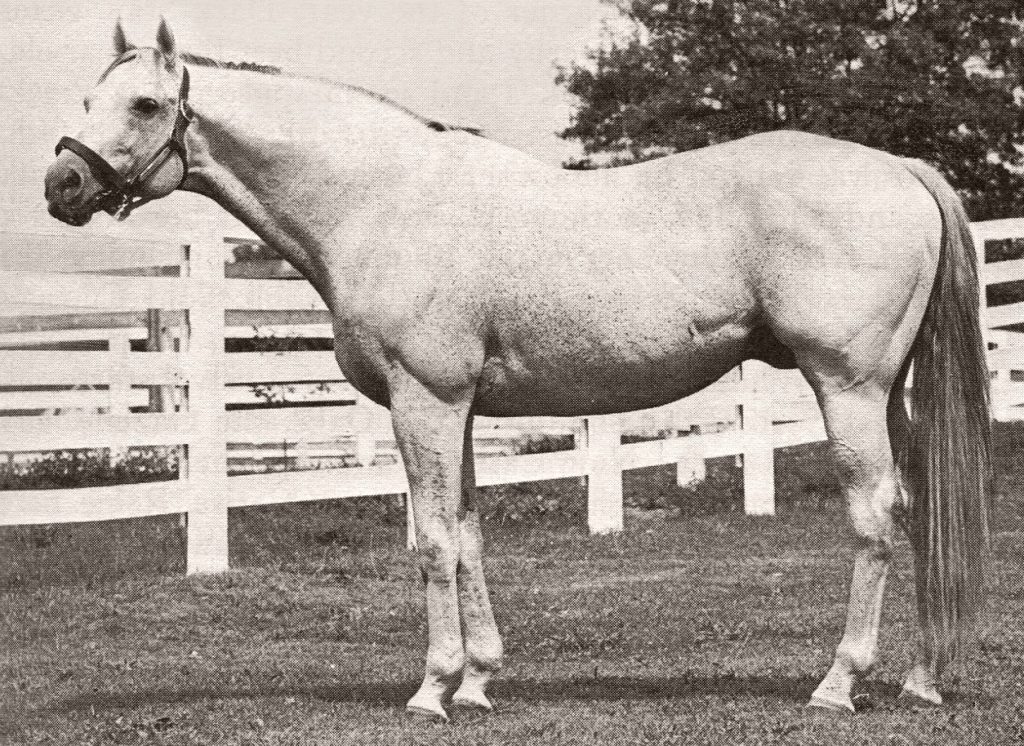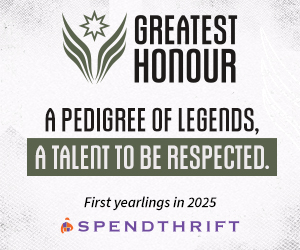
Native Dancer was a massive horse, standing 16.3 hands tall and weighing more than 1,100 pounds. He won 21 of 22 races at 2 and 3, but his pounding style of running took its toll on his relatively weak feet, forcing him to retire at age 4 after a short campaign in 1954.
Unfortunately, he may have passed those same traits on to his progeny.
Jon Weinbach of the Wall Street Journal wrote in 2008 that Native Dancer’s genes produced fast Thoroughbreds who dominated the Triple Crown events, with the rich purses giving owners a safe return on their investments.
Indeed, Native Dancer’s progeny did well as 2- and 3-year-olds: Northern Dancer, Kauai King, and Majestic Prince all came within one race of winning the Triple Crown. Raise a Native was an outstanding 2-year-old before injuring himself.
But something changed in the latter part of the 20th century; as stud fees skyrocketed along with yearling prices, breeders started looking at speed more than longevity, knowing that a horse could prove itself early to command a high price in the breeding shed,
“Back in the 70s we were still breeding horses to race them, and so much of the industry now is concentrated on sales,” said Penny Chenery, owner of Secretariat, back in 2012. “And so you breed a precocious, good-looking, early speed horse who isn’t equipped to go a mile and a half, or to run three hard races in five weeks. We just have a different set of goals with the horses that we breed now.”
Native Dancer was the answer to that line; his grandson, Mr. Prospector, was a sprinter who enjoyed a relatively successful career until he fractured a sesamoid bone. He went on to have an outstanding career at stud, siring 1,195 named foals. By the 2018 Kentucky Derby, every horse entered had Mr. Prospector in his pedigree.
Not all were happy with the dominance of Mr. Prospector in the bloodlines. Andrew Beyer of the Washington Post said in 2008, “America’s breeding industry is producing increasingly fragile thoroughbreds. They may not break down, but they have shorter and shorter racing careers before going to stud to beget even more fragile offspring.”
Several high-profile deaths over the past few decades involved progeny of Native Dancer:
- Ruffian broke her leg in a match race with Foolish Pleasure in 1975 and had to be euthanized; her dam sire was Native Dancer.
- Go for Wand, whose great-grand sire was Northern Dancer, fractured her right cannon bone in 1990 and was put down as well.
- Barbaro succumbed to laminitis after breaking three bones in his right hind leg in 2006; Mr. Prospector was in the third generation on his dam’s side.
- Eight Belles broke both of her front forelegs in the 2008 Kentucky Derby and was euthanized; she had Raise a Native in three different places in her bloodlines.
Was all this because of Native Dancer?
Absolutely not, says Herman D. Lammey, a pedigree researcher. “It’s unfair to blame a single ancestor for breakdowns and injury,” he says. He points to Point Given and Flower Alley as examples of Raise a Native’s progeny who had stamina. “Inbreds and outcrosses suffer injuries at approximately the same rate. It’s probably a function of nutrition, track surface, animal care, training or just a bad step at an unusual angle.”
Alan Porter said essentially the same thing in 2008 after Eight Belles’ breakdown. He told the Baltimore Sun, “To draw a line from a filly breaking down to saying the entire breed is less sound is really a flawed chain of logic. There’s a whole bunch of assumptions that are involved there.”
Lammey says inbreeding is natural part of the Thoroughbred’s ancestral background. “The greatest breeders utilize some form of inbreeding sires and dams in their breeding program with regular success,” he says. The greatest breeders utilize some form of inbreeding sires and dams in their breeding program with regular success.
However, Matthew Binns, animal geneticist at the Royal Veterinary College in London, says that undesirable traits can be passed down from generation to generation, and the more present that line is in a horse’s pedigree, the more likely it is that the horse will possess those traits – like Eight Belles. “The heritability of many deleterious traits in Thoroughbreds isn’t as well established as we’d like, but there is likely a genetic component to susceptibility to bone fractures,” he says.
A closed stud book leads to a slow loss of genetic variation, he says. “The best that can be done is to maintain as much genetic variation within the breed as possible.”
Recent proposals by the Jockey Club to limit stallion books to 140 mares is a step in the right direction, he adds.
To read more about Native Dancer from this author click here.



